|
History Sleuth, Tracking Carnegie’s Church Gifts
Illinois Benefited From Industrialist’s Largess
As you may already know, the Carnegie library movement established through the philanthropy of industrialist Andrew Carnegie at the beginning of the 20th century, had a profound effect on public education in Illinois.
More than 100 libraries were funded by Carnegie in Illinois including the forerunner to the city's present library in Springfield (which unlike the others, does not bear his name) and nearly 1,800 others throughout the United States.
What you may be surprised to learn is that Carnegie loved music as well as literature, and that in addition to libraries, he awarded matching grants for churches and community groups to build pipe organs in more than 8,000 com-munities around the world, including 207 in Illinois.
You'll hear more about his legacy on Tuesday, February 21 at the city of Springfield's Lincoln Library when professional organist and Carnegie organ history sleuth Paula Pugh Romanaux, with the aid of a Powerpoint and microphone, takes a look at Carnegie's pipe organ legacy in Central Illinois and beyond. The free program starts at 5:30 p.m. appropriately in the Library's Carnegie Room.
Dr. Romanaux, who holds both Ph.D., and DMA (Doctor of Musical Arts) degrees, has been researching Carnegie-sponsored pipe organs in Illinois since moving back to the Prairie State in 2017, but her history with these special Carnegie benefactions goes back to her childhood when she learned to play organ repertoire on a Carnegie organ in Virginia, Illinois.
Since that initial experience, Dr. Romanaux has studied and performed on pipe organs throughout Europe, earning her reputation as a master interpreter of 20th century French pipe organ music as well as a performer of Baroque master-works by Bach, Buxtehude, Handel, Scarlatti, and others.
Dr. Romanaux, who earned Bachelor of Arts and Bachelor of Music degrees in music and organ performance at MacMurray College in Jacksonville, was professor of music and organ at Kalamazoo College for 25 years.
She has more than 50 years experience as an organist and choral conductor, and was selected to be a music ambassador to the Balkans in the 1990s, traveling, lecturing and playing pipe organs in Estonia, Latvia, Lithuania, and other republics.
Dr. Romanaux has served as organist for dozens of churches including St. Peter's Episcopal Church in Philadelphia (George Washington's church), St. Stephen's Episcopal Church and Bon Air Baptist in Richmond, Virginia, and most recently at First Presbyterian Church in Springfield from 2018 to 2022.
While living in Petersburg she has discovered and played Carnegie pipe organs in Winchester, Petersburg, Havana, Roodhouse, Girard, White Hall, Divernon, and several other Central Illinois communities, and it is her goal to catalog and
record these instruments before they are lost.
January 17 Panel to Weigh Impact of New Approach to Eyeing History
How should we look at history?
Maybe in ways other than you think.
Sangamon County Historical Society members and guests will get an in-depth look at the changes happening here and on a broader scale as historians, artists, and cut-ting-edge technological experts team to discuss the whys and new ways history can be collected, interpreted, and preserved for future generations.
The free Tuesday, January 17 program, starting at 5:30 p.m. in the Carnegie Room, City of Springfield Public Library, will provide an update and reflection on "Making Our History, Artists Render Lincoln's Legacies" a year-long virtual residency project whose results were on display along with 20 short videos from late August to mid September at the University of Illinois Spring-field, the Springfield Art Association and the Abraham Lincoln Presidential Library.
The paintings, sculptures, prints, photography, virtual reality, conceptual and video art are ear-marked for the UIS permanent collection.
The innovative collaborative art and history project stemmed from conversations between UIS Visual Arts Director Brytton Bjorngaard and Graham A. Peck, the UIS History Department Wepner Distinguished Professor of Lincoln Studies who wound up co-directing the year-long collaborative virtual residency project that drew on a cross-section of approaches by 20 Illinois professional artists, documentary makers and scholars.
To Dr. Peck, who will be among the panelists for the January presentation, there are many Lincolns that inhabit our culture, among them, he says, "the frontier Lincoln, the logician, the family man, the politician, the military chief, the emancipator, the icon, the American God, the pop culture artifact, the Land of Lincoln, and Lincoln's still resounding political legacy."
Dr. Peck will be joined on the panel by some of the artists as well as Josh Hester, principal and executive producer of Springfield-based The Story Teller Studios and his team that documented the artists at work sites or in locations that included New Salem, a museum in Urbana-Champaign and the Abraham Lincoln Presidential Museum.
For details on the November 2022 meeting, check out the back issue of Historico. See Historico tab above.
Meeting Season Opener September 20, Oak Ridge Tour October 2:
On-Site Insight on New Route 66 Fairgrounds
Historic Area Long a Stopping Point for Monarchs
No, not the ones that wear a crown.
The Monarchs in this case are the beautiful butterflies who long before there was a Route 66, twice a year instinctively follow the path of the historic highway, stopping at the Illinois State Fairgrounds as they migrate from eastern and northern United States to Texas and on to breeding areas in Mexico, a 3,000 mile journey.
On Tuesday, September 20, starting at 5:30 p.m., members and guests of the Sangamon County Historical Society will learn how and why their flight ties into the site's new year-round Route 66 Experience complex that not only melds the man-made route to local history, but also provides the delicate creatures with plants that provide nourishing nectar for their trip as well as shelter from predators and harsh weather.
"The Monarchs were already stopping here before the first settlers came to town, drawn by the area's natural abundance of milkweed. They have never veered from the path," notes Society president Susan Helm, one of a group of preservationists who helped create the new lush planting areas that have drawn the butterflies to the new site just west of Peo-ria Road and north of Gate 2. In addition to being able to tour the site, meeting goers will hear experts talk about its design and historical significance and its future development as\a permanent ecological as well as Springfield historical destination both for amateur and professional entomologists and tourists world-wide looking to travel and explore every aspect of the 2,448 mile highway, one of the nation's first interstate hard roads that was made even more popular by author John Steinbeck who in his novel, The Grapes of Wrath, called it "The Mother Road."
For Route 66 fans, historians, preservationists and scientists, the 66-mile wide Monarch Flyway is one of fascination and study.
"The site includes 50 species of native plants and appropriate annuals to support all pollinators, particu-larly Monarchs," says Helm of the project underwrit-ten by state and local grants.
Several speakers are lined up for the program, rep-resenting a cross-section of the business, governmen-tal, historical and conservation communities to create and maintain the permanent year-round Fairgrounds site, said Helm. They include Stephanie Dobbs, a Habitat Specialist with the Illinois Transportation Department, representatives from Ace Sign Company which is providing historic signage for the site, ex-hibit specialist Casey Claypool, executive director of Illinois Route 66 Scenic Byway and a member of the Mother Road Festival board, and Sarah Waggoner, Tourism Manager for the Springfield Convention and Visitor's Bureau.
Program goers will be able to tour the site and talk to the experts about what Route 66 represents both in local history as well as the area's ecology.
"The idea for the site came from Scott Dahl, the Convention and Visitors Bureau director," noted Helm, who has served as the Volunteer Coordinator for the Route 66 Monarch Flyway Project. "The enthusiastic response from the history, busi-ness, government and ecological communities under-scores how the simple flutter of a butterfly wing can bring powerful results," she noted.
---------------------------------------------------------------------------------------------------------------
Oak Ridge Cemetery Walk Set for Sunday, October 2
With a little help from Mother Nature, the Sangamon County His-torical Society will hold its popular cemetery fall walking tour, “Echoes of Yesteryear: A Walk Through Oak Ridge Cemetery” from Noon to 4 p.m. Sunday, Octo-ber 2 at Oak Ridge Cemetery.
The annual event had to be can-celled at the last minute last October when thunderstorms and iso-lated downpours swept the area.
"We're keeping our fingers crossed that Mother Nature will be a bit kinder this year," said Mary Alice Davis, chair of the free event that over the years has drawn thousands to tour significant sections of the historic cemetery at 1441 Monument Avenue in Springfield. (Bus service is provided to and from the parking area to the walking tour site. The last tour begins at 3:15 p.m.).
“As in the past, this year’s Cemetery Walk will provide visitors with a glimpse into the history and heritage of Springfield and Sangamon County,” Davis said.
Actors dressed in period costumes will portray eight individuals who made significant contributions to the community. The personal stories of each historic figure will be interpreted at his or her respective family grave-site, taking the audience back to an earlier time to provides insight into their lives. On this year’s tour:
Harriett Knudson (1883-1969) was the driving force behind the creation of Lincoln Memorial Gardens. She also organized the Springfield Civic Garden Club and started the Springfield PTA Council.
Harriet Palmer Crabbe (1857-1948) and Gertrude Wright Morgan (1861-1931). Palmer Crabbe was the daughter of Springfield School Board member John M. Palmer (1817-1900) and a future Governor of Illinois who successfully led a change in the racially segregated District that would allow black students to attend Spring-field High School. Because of his efforts, Gertrude Wright, the daughter of a wealthy land owner and farm proprietor, became the first African-American student to attend all-white Springfield High School. [Palmer's daughter attended private school]. Following graduation, Wright went onto a teaching career (but not in Springfield, which didn't employ a Black teacher until 1950). Instead she had a stellar teaching career in St. Louis where she met and eventually married a fellow instructor Clement Morgan, the first African-American to graduate from Harvard and Harvard Law School. After moving to Massachusetts, the two became a power-couple in the early Civil Rights movement that led to the creation of the National Association for the Advancement of Colored People. Morgan is buried in Massachusetts.
Richard Dodds (1851-1921) was the owner and operator of a Springfield landmark drug store on the corner of Fifth and Monroe streets known as Dodds’ Corner, which became a de facto city meeting place near street car routes.
Thomas Rees (1850 -1933) was the long-time publisher of the Illinois State Register and Illinois State Senator. Upon his death, he left funds to build the carillon in Washington Park that bears his name.
Salome Paddock Enos (1791-1877) was the wife of Pascal Enos who opened the first land office in the Springfield District. He died at a young age, leaving her to manage his sizable land holdings. In 1837 she donated $3 million worth of property for a new State Capitol.
William A. Northcott (1854 -1917) served as Illinois Lieutenant Governor and U.S. Attorney for the Eastern District of Illinois. He later became Head Consul of Modern Woodmen of America, a fraternal life insurance company that erected his monument.
William Carpenter (1787 -1859) was an early settler who owned a ferry operation along a stagecoach line. The settlement was known as “six-mile house.” He later served as Springfield postmaster and had extensive real estate holdings. Carpenter Street and Carpenter Park are named after him.
Attendees will be transported by bus to the first gravesite, then walk to the other grave-sites before boarding the bus back to the parking area. The walk is approximately one-half mile. Refreshments will be available for purchase by the Springfield and Central Illinois African American History Museum.
The popular cemetery walk, which is sponsored by the Sangamon County Historical Society and co-sponsored by Oak Ridge Cemetery, was held annually for 12 years beginning in 1996 and ending in 2008. Brought back seven years ago by popular demand, Covid and then weather conditions prompted cancellation for the past two years. "While the event is free to the public, donations will be accepted," Davis noted. "Parking will be in designated areas of the cemetery. Just follow the signs."
----------------------------------------------------------------------------------------------------------------
Society Elects Officers, Board Members for 2022-2023
Members of the Sangamon County Historical Society unanimously voted in a new slate of officers and directors at the organization's annual dinner meeting held June 21 at the Clayville Historic Site in Pleasant Plains.
Four officers and six directors whose terms range from one to three years were elected. Top spot went to Susan Helm, president, who previously served as vice-president. Cinda Klickna was elected vice-president; Sarah Adams, secretary, and Jerry Smith, treasurer. Klickna and Adams had previously served as directors. Smith is continuing as treasurer, a post he has held since 2014. Former president Stephanie Martin, whose two-year term ended with the annual event, will continue to serve on the board as past-president, a non-elective position.
The board is also composed of 15 directors, with groups of five elected each year to three year terms.
Elected as Directors were Scott Pillsbury, Kathy Dehen, Elaine Hoff, Larry Stone, Angela Weiss and Vicky Whitaker. Pillsbury, Dehen, Stone and Weiss previously served as Directors. Hoff is a past vice-president of the Society. Whitaker is a past president.
_____________________________________________________________________
2021-2022 MEETING ARCHIVES...MEETING ARCHIVES...MEETING ARCHIVES
May 17, 2022
Saving Local History By Documenting COVID 19
COVID 19 and its frequent mutations continue to have a profound impact on our daily lives, a circumstance not unnoticed by historians here as elsewhere.
The Society's Tuesday, May 17 program meeting will bring together representatives from three major area history organizations who will provide a behind-the-scenes look at how they are compiling that information for future generations.
The program will be held in Carnegie Room North at the City of Springfield's Lincoln Library, 326 S. Seventh Street, starting at 5:30 p.m. Admission is free and open to the public.
Panelists will include Sangamon Experience at the University of Illinois at Springfield director Anne Moseley who will talk about the UIS history “Covid19 Project” designed to record and preserve the personal experiences of students, faculty, and staff during the Corona Virus outbreak.
Amanda Riggenback, Project Manager for the Abraham Lincoln Presidential Library and Museum, will detail its “Tumultuous 2020” oral history project and a third panelist, Amanda Breyden, Registrar for History and State Historic Sites for the Illinois State Museum, will provide insight into the state agency's “Illinois Stories-COVID” collection.
April 19, 2022
A Trip Down Fourth Street: Springfield’s Best Address
You won't need your walking shoes to learn about the area that was once Springfield's best address. Just take a seat at the Sangamon County Historical Society's Tuesday, April 19 meeting to get a virtual tour and insight into the city's most prominent fami-lies who lived along and around South Fourth Street from East Lawrence to just north of Jackson Street.
The program, to be held in Carnegie Room North at the City of Springfield's Lincoln Library, 326 South Seventh Street, is free and begins at 5:30 p.m.
Providing the details for this in-person Powerpoint presentation will be local history experts Allison Smith and Cinda Klickna, each bringing in-depth knowledge about the area as part of their in-volvement with the Dana-Thomas Foundation. Smith is a former Foundation board member and has been a docent at the Dana-Thomas House for a decade. Clinka, a current member of the Foundation Board (and Sangamon County Historical Society board member), is a free-lance writer and author. Both have extensive backgrounds in education.
At the heart of the program, as it was in its heyday, is the 12,000 square foot, 35-room Dana Thomas House on East Lawrence Avenue designed by famed architect Frank Lloyd Wright in 1902 for socialite and civic leader Susan Lawrence Dana. Architecturally striking then as now, today it is a popular tourist attraction, a National Historic Landmark that's listed on the Register of National Historic Places.
In 2020, the Society awarded the Foundation a Special Projects Grant to produce a self-guided walk-ing tour booklet that visitors can use to tour the historic sites in the neighbor-hood anchored by the Dana-Thomas House. The homes and those who lived in them will get an up-close look when the presentation duo shares their stories.
The rambling Dana-Thomas House sits on the site of the home of Rheuna D. Lawrence, who at the time of his death in 1901, was president and one of the largest stock-holders of Springfield's State National Bank. He also owned extensive commercial and agricultural property in the area and silver and gold mines in Colorado and California, respectively.
Lawrence had served as Mayor of Springfield and was president of the school board. But it was his daughter, Susan Dana, who would eventually set the area apart from other neighborhoods across the city. When she gave Frank Lloyd Wright an open checkbook to build the house she inherited from her father, only one room, a parlor with a Victorian fireplace, was left intact in his memory.
The new house cost ap-proximately $60,000 at a time when an eight-room brick house would have cost $4,000 and a six-room frame house $1,500, no match even for the mix of existing and future homes and mansions that would rise in the area.
The April 19 program will take a closer look at the social life and business and professional connec-tions that crisscrossed the area and its ups and downs as the city continued to grow.
March 15 Meeting: “Lost Fashion”
ARCHAEOLOGIST TO SHARE RIOT SITE FINDINGS
Archaeology is more than digging up the past.
For Chelsea Coates, it also includes piecing together what's found.
Coates, part of the Springfield-based archaeology research firm Fever River Research's team sorting through artifacts from the August1908 Springfield Race Riot, will detail her work and findings at the Society's Tuesday, March 15 meeting.
The meeting will be held in the Carnegie Room North at the City of Springfield's Lincoln Library, 326 South Seventh Street, starting at 5:30 p.m. The Society's January and February meetings were presented online, reflecting Covid guidelines limiting large gatherings, an issue the Society has been addressing month-by-month.
As it has for other historical sites across the region, Fever River was tapped to do an archeological survey before construction could begin on the Carpenter Street underpass rail project, one that involved doing a partial excavation of five houses destroyed during the riot, all of them constructed in the 1840s and early 1850s. Archaeological testing began in late 2014 and in 2018 resulted in a decision to shift the railroad right of way to the east to preserve in place those houses.
Archeological site work was completed in 2020. Since then, Fever River has been processing and inventorying the artifacts from the houses.
Last October, Coates and her colleagues -- archaeologist and architectural historian Christopher Stratton and Fever River director Floyd Mansberger -- detailed some of their findings for teachers and historians in a three-part presentation at the annual Conference on Illinois History held in Springfield. The presentation was entitled "Why Bother with the Archeology of Burned Houses from 1908: The Significance of the Archeology of Mob Violence on Jim Crow Era Black Households in the Post-George Floyd Era." Coates is expected to review and update her portion of the original presentation for the Society's March meeting.
The finds in a charred and burned trunk and dresser from one of the houses has provided Coates and her colleagues with a treasure chest of fragments and buttons from clothing-related items such as corsets and shoes.
In addition, there were over 1,200 fabric fragments that have been sorted into individual garments, household linen and other personal accessories including such common personal items as a handkerchief and an umbrella.
Coates joined Fever River Research in August, 2019 after earning a Bachelor of Arts degree with honors in anthropology in 2011 and a Masters degree in historical archeology in 2014, both from the University of Tennessee, Knoxville. Coates also earned a Masters degree in Cultural Resource Management from Colorado-based Adams State University in 2021 and is a Field Archaeologist at the University of South Carolina.
View this month's Historico HERE.
Now Online: from Past to Present
HOW TECHNOLOGY AND SAVVY SHAPED MOVIE THEATER INDUSTRY
Reflecting months of research, for its January 18 on-line program, the Society has taken an indepth look at the people and the technological forces that through much of the 19th and 20th centuries, made Springfield the bell-weather for the entertainment industry, its audiences gauged by national movie makers and performers as a make or break factor.
While those days are gone, usurped by even newer technology that would eventually make the original movie houses here obsolete, the movie theater industry was once vibrant, making fortunes for some of its earliest and often young technologically savvy enthusiasts, and laid the groundwork for at least two major movie chains.
The Power Point presentation--on YouTube and as a PDF--explores everything from nickelodeons and Air Dome theaters, to the fanciest movie houses and their attempts to stay relevant as customer tastes, population shifts, radio, television, DVDs, CDs, and more recently home-viewing movies on Netflix and pay channels have eaten into movie going audiences. The link will take you directly to either site.
“With the continuing spread of the Covid variant, we felt it was in the best interest of our members to put our January program on–line rather than gather in person,” explained SCHS president Stephanie Martin.
The January issue of the Society's newsletter, Historico, can provide you with a primer about early entertainment that should whet your appetite for the full program that can view on-line.
On Screen Debut Nov. 16, A Tell-All On Secret Poet’s Life
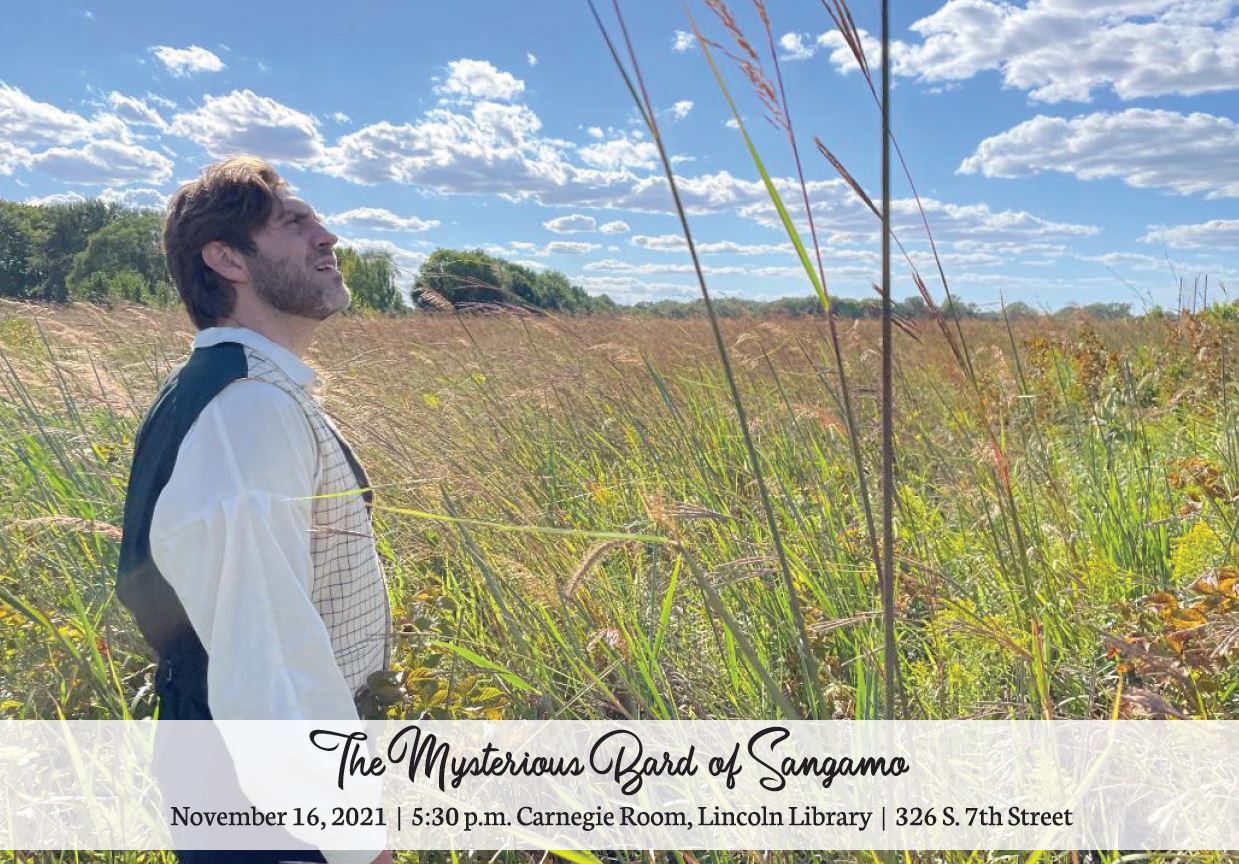
You may have heard the talk or read about it in the press. And now, thanks to a joint presentation by the Sangamon County Historical Society and the Iles House Foundation on Tuesday, November 16, you can catch the story of the lost poet of Abraham Lincoln's Springfield on the big screen.
The two organizations will co-host the first public big screen showing of "The Mysterious Bard of Sangamon," a new film based on the life of talented poet John Hancock, a well-traveled, well-educated Englishman who made his home in Springfield in the 1830s and 1840s, and identified authorship of his work when it was published in the frontier newspaper, the Sangamo Journal only with the letter "H."
The program, in the Carnegie Room at the City of Springfield's Lincoln Library, is free and open to the public. The presentation begins at 5:30 p.m. Attendees will be required to adhere to state and federal Covid mask and seating regulations.
You can also download and watch the film on line at https://vimeo.com/626671152/daae07f0cc .
As successful as he was locally over 150 years ago, Hancock faded into obscurity until award-winning literary scholar, teacher, historian and author Dr. John E. Hallwas recognized the breadth of his talent and spent decades tracking down his work and identify the elusive poet. The new film is the latest effort to underscore Hancock's literary place in history.
In a book he wrote about Hancock, The Poems of H., the Lost Poet of Lincoln's Springfield, published in 1982, Dr. Hallwas noted that the Springfield bard produced "what may be the finest poetic achievement in the Midwest before the twentieth century," speculating that his anonymity was the probable result of his living on the edge of the Illinois frontier instead of "Boston, New York, or Cincinnati."
Now a Distinguished Professor Emeritus at Western Illinois University, Dr. Hallwas wrote the play on which the screenplay is based, explained Illinois State Historical Society Executive Director William Furry, a project that he had been discussing with him over the years.
Furry served as producer and director of the film, organizing and hiring the professional cinema team and casting actor Victor Holstein to play Hancock who donned authentic period clothing for the film, loaned by the Abraham Lincoln Presidential Library & Museum. Holstein is a Springfield native, a graduate of Glenwood High School and an established television actor and producer.
Working with a miniscule budget (by Hollywood standards) provided by Dr. Hallwas and individual donations and a grant from SCHS through its Special Projects awards program, the film was shot over the summer in and around Sangamon County historic sites including interiors at Iles House.
Springfield cinematographer Brian Crowdson and his assistant, Karen Nickerson handled the production details. Keyboard artist and organist Paula Pugh Romanaux and Wild Columbine, a group that performs traditional music, provided the soundtrack for the hour-long movie.
That there had been a mystery bard afoot during the Lincoln era comes as no surprise to long-time Sangamon County Historical Society members who in 1986 heard Dr. Hallwas talk about his efforts to track down the creator of dozens of poems that proved popular with Sangamo Journal readers.
Hancock, who had moved to Springfield from London, England, penned poems that ranged from sonnets about nature and philosophy, satirical and mock-heroic works presented in observations of local citizens, events, and customs, or legendary or mythological themes as well as poems of remembrance. The Sangamo Journal often printed his poems on the front page, noted Historico, in reporting on the historian's presentation to the Society in 1986.
(09/14/2021)
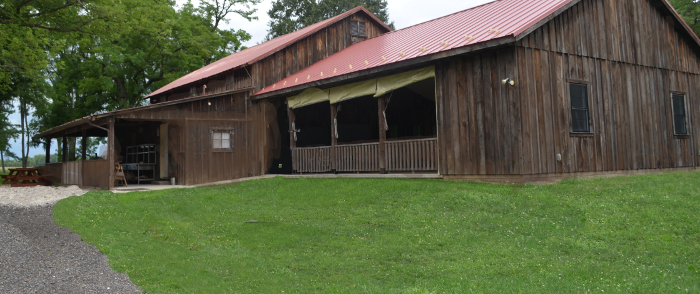
Society Opens Season at Historically Significant Site
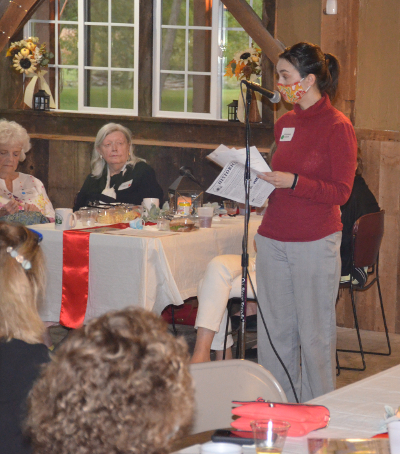 It wasn’t by design but in retrospect, it seemed appropriate that the Society’s return to in-person meetings on September 14 was held at the Clayville Historic Site in Pleasant Plains. It wasn’t by design but in retrospect, it seemed appropriate that the Society’s return to in-person meetings on September 14 was held at the Clayville Historic Site in Pleasant Plains.
A recent compilation of the Society’s 60 year-history found the geographical connection: after a series of organizational and board meetings when the Society was formed on June 12, 1961, its very first public meeting was held at Clayville on October 1, 1961!
This year’s event included a box dinner and the introduction of winners of the Society’s 2021 Special Project Grants...and of course, face-to-face socializing albeit masked except when dinner goers partook of an array of sandwiches, salad, fruit and dessert from Nelson’s Catering.
As a popular spot for events and receptions, the Pleasant Plains Historical Society representatives who operate the site were well-versed on the restrictions Covid has placed on large gatherings, setting up seating and dining that gave the more than 50 SCHS members and guests plenty of elbow room.
------------------------------------------------------------------------------------------------------------------------------------------------------
2019-2020 Programs and Events (03/12.2020)
2020 Trivia Night Cancelled Over Covid Concerns
In light of increasing health concerns about the Coronavirus (COVID-19), the Sangamon County Historical Society has cancelled its 8th annual Trivia Night that was scheduled to be held on Saturday, March 21.
Our primary concern is the health and safety of our community. We are joining other Illinois organizations in taking this precautionary measure where public gatherings are planned.
If you have already sent a check or have processed a payment and it’s in the mail, we will return your payment in the next few days. If your payment has not been cashed, we will return the check to you or your organization or if it has been cashed, we will issue a check to you from the Society.
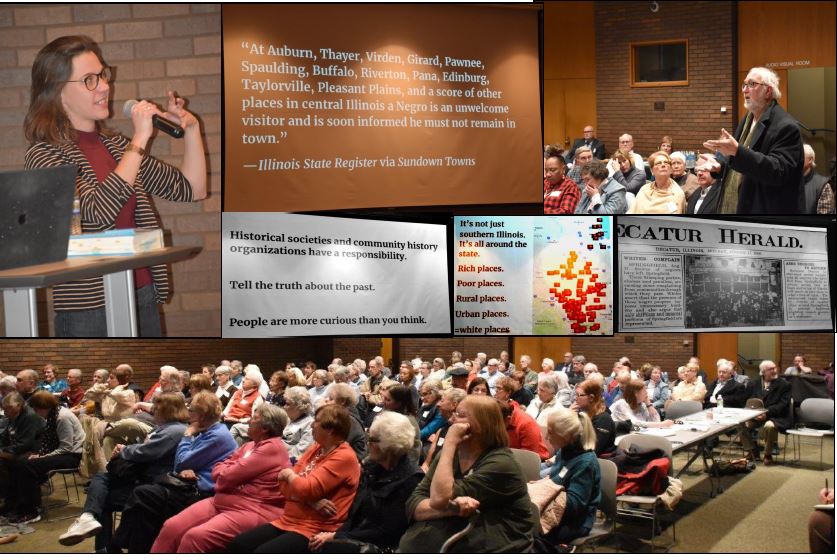
HISTORY LESSON: Speaking to members and guests of the Sangamon County Historical Society and the program's co-sponsor, the Springfield and Central Illinois African American History Museum on February 18, Chicago-based journalist Logan Jaffe detailed the steps she took in researching and writing "The Legend of A-N-N-A: Revisiting an American Town where Black People Weren't Welcome After Dark," jointly published this past November by The Atlantic Monthly and ProPublica Illinois. Anna, a small (population 4,000) community in southern Illinois, mirrors many of its counterparts across the state and around the nation as a former "Sundown Town" that from the post Civil War period through the mid 1900s either by legislation, signage, or practice, threat-ened African Americans with harm if they entered or stayed in the community after sunset. Springfield, whose 1908 race riot became a rallying cry for similar events through the 1920s and beyond, was surrounded by small communities who gave no haven to those fleeing the riot, Jaffe noted in a series of slides that illustrated the wide-spread racism in Illinois that extended to news re-ports, real estate, public policy and more and shaped the demographics of communities in the decades that followed. Jaffe, who joined to ProPublica by way of The New York Times and Chicago Public Media (WBEZ), emphasized the important responsibility historical societies and community history organizations have in telling the truth about a community's past. "People are more curious than you think," she said, in detailing her experience talking to Anna residents ignorant of their community's racist past. Larry Stone photos
(02/11/2020)
February 18: Investigating Sundown Towns:
An Overlooked Legacy of Racism in Illinois
It took 100 years for Springfield to officially mark the 100th anniversary of the 1908 Race Riot. It is taking even longer to have its location designated a national historic site.
Sometimes lost in the Race Riot's telling is, as one prominent historian noted, "a hidden dimension," the racist actions of white residents in some of the smaller communities surround-ing Springfield who barred entry, threatened and refused aid or shelter to black Springfield residents fleeing the riot for their lives.
Known as "Sundown" towns, either by ordinance, practice and/or signage, they barred African Americans (and in some cases other ethnic or religious groups) from being in their communities after sunset. And although their actions in the 1908 riot may have faded with time, their long-term impact on residential and racial demo-graphics of Illinois has not.
Taking a closer look on the subject will be Logan Jaffe, a reporter for Chicago-based ProPublica Illinois, whose story on contemporary Anna, (population 4,000) in Union County, Illinois, "The Legend of A-N-N-A: Re-visiting an American Town Where Black People Weren't Welcome After Dark" was jointly published with Pro-Publica in the November 2019 edition of The Atlantic Monthly.
Jaffee will be the Sangamon County Historical Society's guest speaker on Tuesday, February 18, in a program co-sponsored with the Spring-field and Central Illinois African-American History Museum. The free program begins at 5:30 p.m. in Carnegie Room North, in the city of Springfield's Lincoln Library.
A-N-N-A, whose name became a catch phrase to describe racist Illinois Sundown communities, drew the interest of Jaffee, an investigative reporter who traveled to the downstate community after reading James Loewen's extensively researched book, Sundown Towns: A Hidden Dimension of American Racism, published in 2005 and updated in 2018. An Illinois native and college professor, Loewen started researching the subject in 1990, expect-ing to find about 10 in the state and 50 around the country. Much to his surprise, he found 507, two thirds of all the towns in Illinois. In the preface to his updated book, he noted that Sun-down towns in Illinois as elsewhere, are on the decline as the nation be-comes more multiracial.
Jaffee, who came to ProPublica by way of The New York Times and Chicago Public Media (WBEZ), talked to Anna residents and officials, studied census figures and demographics, historic documents and probed the question of whether the community is aware of or willing to confront its history like some other Midwest former Sundown towns have done. For the February meeting, Jaffee will talk about both her research and the interview process by which she put her article together.
No stranger to the topic, Jaffee was the multimedia producer for WBEZ's Curious City, a journalism project fueled by audience questions about Chicago, and previously an embedded media-maker with The New York Times' Race/Related newsletter in collaboration with the documentary showcase POV, in which she reported and produced an audience-driven project confronting the pervasiveness of racism through everyday objects. Jaffee was also a producer with The New York Times Daily 360 project. In Chicago, she was a recipient of Chicago Film-makers' Digital Media Production Fund for "Battle Flag," an interactive documentary which questions the meaning of the Confederate battle flag in America.
A Miami native, Jaffee earned her degree in photojournalism from the University of Florida in 2011.
Joe Crain Tapped to Emcee Society’s Eighth Annual Trivia Night March 21
Joe Crain, the popular former WICS-TV Springfield meteorologist who now directs public programs for the Abraham Lincoln Presidential Library & Museum, will emcee the Society's Eighth Annual Trivia Night fundraiser set for Saturday, March 21 in Parish Hall at Christ the King Church, Springfield.
Tickets for the event are now on sale on-line at the Society's website, sangamonhistory.org. or can be purchased by mail using a downloadable form from this site Table-purchasing early birds have a sign-up incentive: one or more of 12 reserved up-front tables. Tables of 10 are $100. Individual seats are $10. You can purchase both on line following the link on this site's home page or by mail, by downloading a mail-in form..
You or your company can sponsor an individual round of questions, with your company logo or message appearing on the screen and announced at the start of one of the 10 rounds of trivia questions that make up the Trivia Game.Round sponsorships are $100. For information about Round sponsorships, contact the Society at sangamon-history@gmail.com or call 217-525-1961.
With questions and categories devised by well-known Trivia Night guru Al Gietl, tables will be vying for a $200 first prize with second and third prizes of $100 and $75 to the runners up.
Doors open at 6 p.m., with the game starting at 7 p.m.
Prize-winning chef Les Estep’s tasty chilli will once again be available to Trivia Night players throughout the evening along with snacks. Wine, beer, soda and water will also be available for purchase.
Proceeds from the event benefit the Sangamon County Historical-Society’s Special Projects fund.
(01/03/2020)
Writers to Share Story Behind the Story January 21
Researching and writing about local history isn't for the faint-hearted. And digging into history can sometimes bring surprising results: backstories, funny facts and a myriad of other information that sometimes doesn't make it into print...or does it?
A team of well-known local writers will share their surprises and more with Society members and guests on Tuesday, January 21 when they gather to discuss...and maybe reveal...some of the more unusual, humorous, and per-haps scandalous historical facts and myth-busters they've discovered as they've plowed through old records, dusty photos or conducted face-to-face interviews.
What they've found and how they've dealt with it will be the focus of the Society's January program meet-ing, 5:30 p.m., Carnegie Room North at the City of Springfield's Lincoln Library. The session is free and open to the public.
The four--Mike Kienzler, Taylor Pensoneau, Cinda Ackerman Klickna, and Tara McClellan McAndrew--are familiar to area history buffs and are all Society members.
 After almost 40 years as an editor and reporter for The State Journal-Register, Kienzler retired in 2013 to become the founding editor of SangamonLink.org, the Sangamon County Historical Society's prize-winning online and searchable encyclopedia of Sangamon County history. After almost 40 years as an editor and reporter for The State Journal-Register, Kienzler retired in 2013 to become the founding editor of SangamonLink.org, the Sangamon County Historical Society's prize-winning online and searchable encyclopedia of Sangamon County history.
A Springfield native, Kienzler is a graduate of Bradley University and received his master’s degree in Public Affairs Reporting from what was then Sangamon State University. He was inducted into the PAR Hall of Fame in 2017. A former president of the old Clayville Folk Arts Guild and a former member of the Illinois State Historical Society advisory board, and he currently is on the board of directors of the Menard County Historical Society.
 A native of Bellville, for more than two decades, Pensoneau, a graduate of the University of Missouri School of Journalism, covered Illinois politics for the St. Louis Post-Dispatch before switching careers and spending 26 years with the Illinois Coal Association. A native of Bellville, for more than two decades, Pensoneau, a graduate of the University of Missouri School of Journalism, covered Illinois politics for the St. Louis Post-Dispatch before switching careers and spending 26 years with the Illinois Coal Association.
After retiring from its presidency in 2003, he returned to writing, this time as author of several highly-praised non-fiction books including two on former Illinois governors: Dan Walker, the Glory and the Tragedy and Governor Richard Ogilvie: In the Interest of the State. He also wrote a book about State Senator W. Russell Arlington, Power-house:Arlington from Illinois.
Pensonseau didn't confine all of his research to politics. His book, Brothers Notorious: The Sheltons, documented the exploits of a group of downstate Illinois gangsters and Dapper & Deadly: The True Story of Black Char-lie Harris, chronicled the life of one of the last famous gangsters from south-ern Illinois. He also produced two works of fiction, The Summer of 50 and Falling Star. Pensoneau served as president of the Sangamon County Historical Society from 2006 to 2007 and was the keynote speaker at the Society's annual dinner in 2016.
 A freelance writer for more thn 20 years, McAndrew, who holds a bachelor's degree in English and a masters in Public Affairs Reporting, has worked in a variety of media. She has covered Illinois state government for National Public Radio and helped produce pieces for the BBC, Soundprint and the Australian Broadcasting Corporation. A freelance writer for more thn 20 years, McAndrew, who holds a bachelor's degree in English and a masters in Public Affairs Reporting, has worked in a variety of media. She has covered Illinois state government for National Public Radio and helped produce pieces for the BBC, Soundprint and the Australian Broadcasting Corporation.
Her articles have been printed in dozens of magazines and newspapers including The Hollywood Reporter, Chicago Tribune Magazine, Illinois Issues, Christian Parenting Today, and Odyssey. McAndrew has also writ-ten five full-length plays and one-act scripts, several of which were commissioned by local historical sites or agencies. She has spent the last 10 years specializing in writing about history, especially that of Central Illinois and Abraham Lincoln.
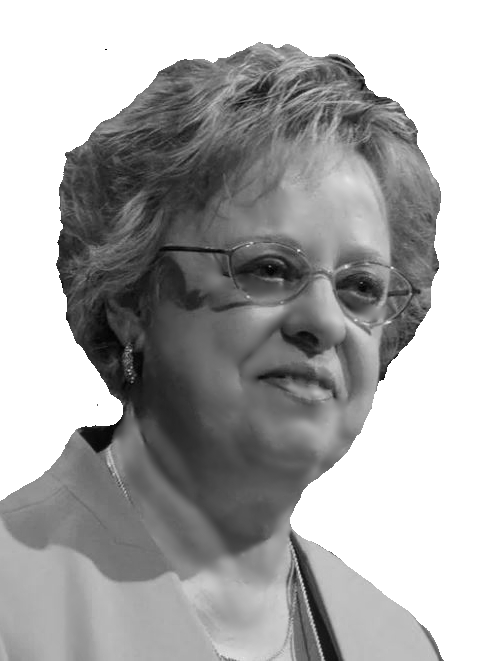 Klickna, a free-lance writer whose work frequently appears in Illinois Times, holds a bachelor's degree in English Education from the University of Illinois, Urbana, and a Master’s in Literature from the University of Illinois, Springfield. She taught English in the Springfield School district for many years and held several positions with the Illinois Education Association and the National Education Association. Klickna, a free-lance writer whose work frequently appears in Illinois Times, holds a bachelor's degree in English Education from the University of Illinois, Urbana, and a Master’s in Literature from the University of Illinois, Springfield. She taught English in the Springfield School district for many years and held several positions with the Illinois Education Association and the National Education Association.
Klinckna retired in 2017 after serving six years as President of the Illinois Education Association.
A member of the boards of the Dana Thomas House Foundation, the Illinois State Museum Society and the Illinois State Historical Society, Klickna served as a trustee of the Illinois Teachers’ Retirement System from 2003-2019. She is also on the board of the Illinois Educators’ Credit Union and the United Way Education Vision Council.
(11/3/2019)
At November 19 Meeting, ALPLM Oral Historian
Mark DePue to Share War Veterans Memories
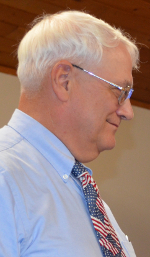 Members and guests of the Sangamon County Historical Society will learn what veterans had to say about the battles they fought in a special post Veteran’s Day pres-entation November 19 with Mark DePue, head of the Oral History Program at the Abraham Lincoln Presidential Library. Members and guests of the Sangamon County Historical Society will learn what veterans had to say about the battles they fought in a special post Veteran’s Day pres-entation November 19 with Mark DePue, head of the Oral History Program at the Abraham Lincoln Presidential Library.
The program, at 5:30 p.m. in Carnegie Room North at the City of Springfield’s Lin-coln Library, is free and open to the public, resuming the Society’s regular monthly pro-gram schedule.
DePue’s talk and Powerpoint presentation will focus on the memories of Illinois veterans of World Wars I and II, Korea, Vietnam, the Cold War, Gulf War, and the War on Terror as captured in interviews collected for the Oral History program's "Veterans Remember" series.
A native of Decorah, Iowa, DePue holds a bachelor of science degree from West Point and Master of Arts and Doctor of Philosophy degrees from the University of Iowa, He was an Army officer for 25 years. He joined the faculty of Lincoln Land Community College from 2001 to 2005 as an adjunct professor and freelance writer.
DePue served as a senior analyst at the Headquarters of the Army National Guard in Arlington, Virginia before being named Oral Historian for the Abraham Lincoln Presidential Museum and Library in 2006.
(Posted 11/3/2019)
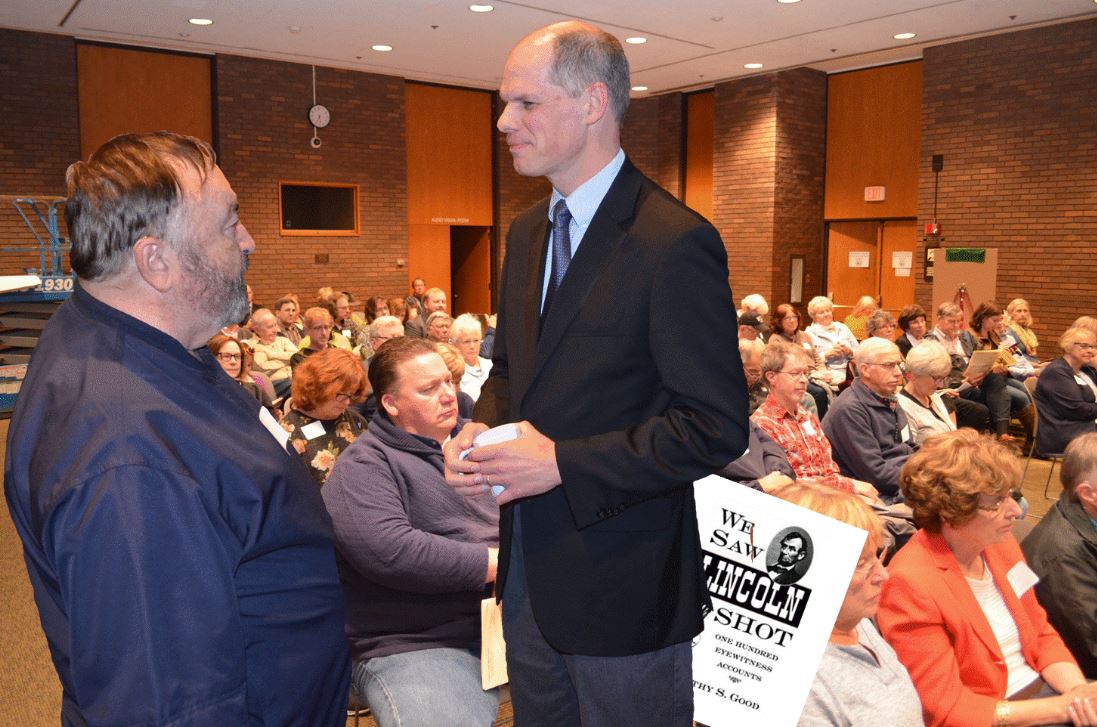
FULL HOUSE: Lincoln historian Timothy Good (right) chats with well-known Ulysses S. Grant reenactor Larry Werline (left) following Good’s presentation October 22 to the Society on the eyewitness reports of Lincoln’s assassination. Werline was among a full house of history buffs on hand for the talk at the City of Springfield’s Lincoln Library that heard Good dispute some of the post-shooting reports. Good is Superintendent of the Lincoln Home in Springfield and was assigned to Ford’s Theater in Washington, D.C. early in his National Park Service career, inspiring the research that resulted in his book.
(Posted 10/12/19)
October, November Programs to Give
Unique Views of Illinois History, People
October and November will bring some thought-provoking programs to Society members, with speakers well-honed in their subject matter.
The Society, which usually holds its program meetings on the third Tuesday of each month, makes an exception in October in order to hear historian Timothy Good share what he learned by taking a close look at the personal accounts of those who were in Ford Theater the night Lincoln was shot that differ from later reports used by historians and others to relate the circumstances surrounding the shooting and its aftermath. exception in October in order to hear historian Timothy Good share what he learned by taking a close look at the personal accounts of those who were in Ford Theater the night Lincoln was shot that differ from later reports used by historians and others to relate the circumstances surrounding the shooting and its aftermath.
Good is no stranger to the Ford's Theater or Lincoln...and no stranger to Springfield, where in his position as superintendent of the Lincoln Home National Historic Site here, began his career 28 years ago with the National Park Service in Washington D.C. at the Ford’s Theater National Historic Site.
His book, We Saw Lincoln Shot: One Hundred Eye Witness Accounts will be the foundation of his presentation to the Society at 5:30 p.m. in Carnegie Room North. The program is free and open to the public.
Good has also written three other books, American Privateers in the War of 1812: The Vessels and Their Prizes as Recorded in Niles’ Weekly Register, Lincoln for President: An Underdog’s Path to the 1860 Republican Nomination and The Lincoln-Douglas Debates and the Making of a President, reflecting his interests in naval history and American history.
Good, who became Superintendent of the Lincoln Home National Historic Site in Springfield in 2018, holds a Bachelor of Arts degree from Valparaiso University, a Master of Arts from the University of Durham, England, and earned a diploma from the United States Naval War College.
The Society resumes its regular meeting third Tuesday of the month schedule on November 19 with a post-Veterans Day program featuring Mark DePue.
DePue, head of the Oral History Program at the Abraham Lincoln Presidential Library, will talk about the memories of Illinois veterans of World Wars I and II, Korea, Vietnam, the Cold War, Gulf War, and the War on Terror as captured in interviews for the program's "Veterans Remember" series.
The presentation will begin at 5:30 p.m. in Carnegie Room North at the city of Springfield’s Lincoln Library.
A native of Decorah, Iowa, DePue holds a bachelor of science degree from West Point and Master of Arts and Doctor of Philosophy degrees from the University of Iowa, He was an Army officer for 25 years,
He joined the faculty of Lincoln Land Community College from 2001 to 2005 as an adjunct professor and freelance writer. Depue served as a senior anaylst at the Headquarters of the Army National Guard in Arlington, Virginia before being named Oral Historian for the Abraham Lincoln Presidential Museum and Library in 2006.
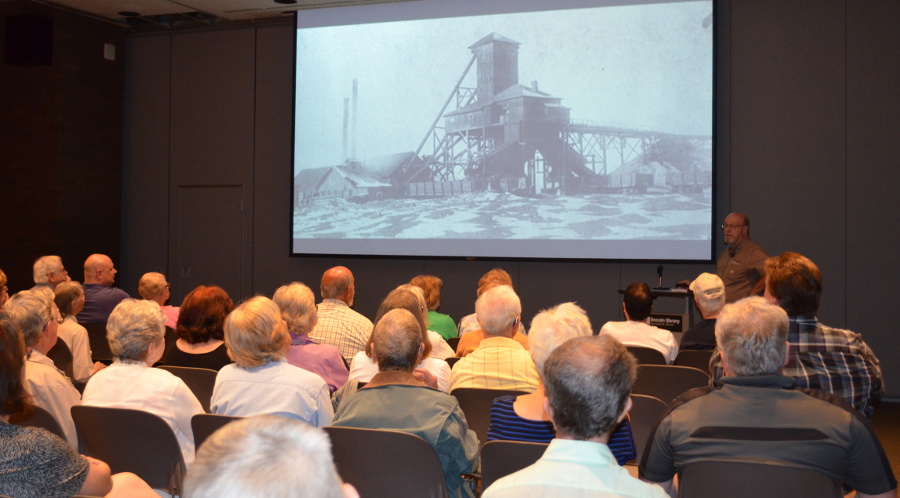
AUTHOR Ken Mitchell shares the untold story of Devereux Heights to a full house of members and guests September 17, kicking off the Society's meeting season at the City of Springfield’s Lincoln Library. His new book, The Little Village That Could, provides insight into Springfield history and its ties to coal mining. Below, Mitchell signs a copy of his book for member Francie Staggs.
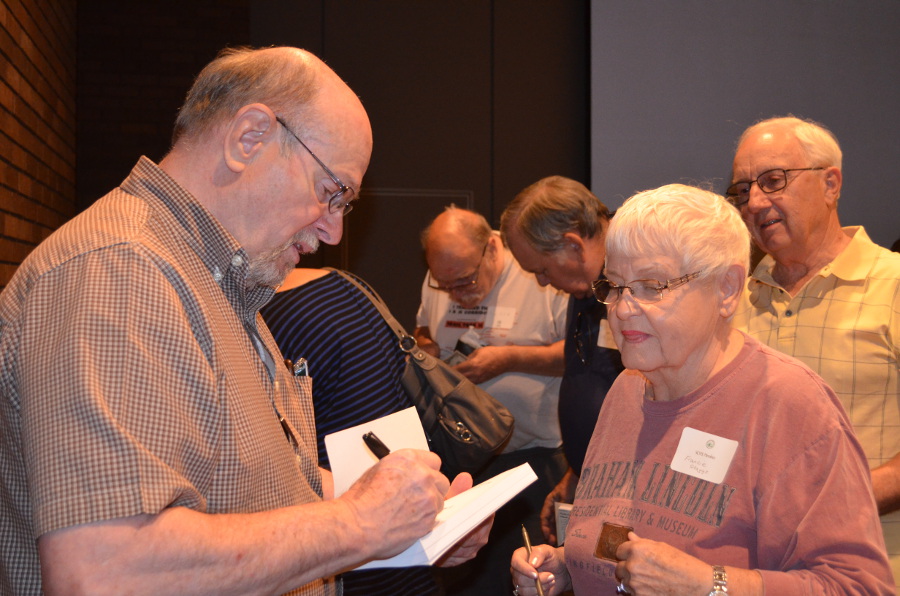
(Posted 9/2/19)
Season Opener September 17
Devereux Heights Finding Place in Local History
Thanks to Writer/Reseacher With a Story to Tell
The winds of change can sometimes blow a village off the map. Jobs vanish as industries depart, super-slabs and shopping centers rip across pastures, groves and farm fields. Families move on.
Except for Devereux Heights, a feisty 106- year-old hamlet on the northern-most end of Springfield that has defied fading away.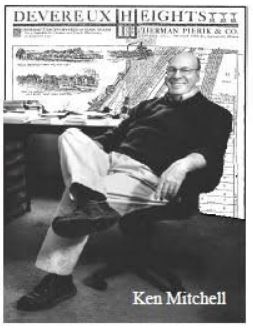
On Tuesday, September 17, you'll learn more about this close-knit neighborhood with deep roots to Sangamon County's past, when author Ken Mitchell shares what he's learned about the area and put into a new book, The Little Village That Could: The Untold Story of Devereux Heights.
His presentation, kicking off the Society's 2019-2020 program series, begins at 5:30 p.m. in Carnegie Room North in the City of Springfield's Lincoln Library and is free and open to the public.
Author and raconteur Mitchell is no stranger to Springfield's north end. Among the 15 books and several shorter pieces he's written about the people and places that shaped his life there are North End Pride, The History of Lanphier High School and Growing Up in Rabbit Row, a look at the colorful north side neighborhood in and around Reservoir Street from Ninth to 15th Streets in which his father grew up. Reservoir Park, once one of the city’s most popular and beautiful family recreation areas that was plowed under in the early 1930s to make way for the construction of Lanphier High School.
While doing research for North End Pride, Mitchell's curiosity about other small North End neighborhoods was piqued, although information was sparse. He made a mental note to pursue that route once he finished other writing projects. That moment came four years ago in conversation with a former Devereux Heights resident who offered to share his memories and contacts. It spurred some interviews but, noted Mitchell, not enough for a book.
Three other writing projects took precedence until earlier this year, when Mitchell was able to pursue the Devereux Heights story, a unique "company coal town" whose residents benefitted from an unusual real estate deal that allowed them to avoid the fate of their counterparts when the coal ran out.
Mitchell, who holds degrees from Millikin University in history and political science and from the University of Illinois, Springfield, in biology and education, has had a varied 40-year business career spread across real estate, farming, horse breeding, insurance, sales and marketing.
(Posted 9/2/19)
Looking at the Legacy of Harry H. Devereux
Harry H. Devereux (1866-1926), whose name is forever linked to Devereux Heights, was a savvy businessman and popular political leader who served two terms as mayor of Springfield (1901-1904).
His mother, Marie L. Devereux, believed to be a widow, moved to Springfield in 1871 from Detroit, Michigan, with six-year old Harry in tow.
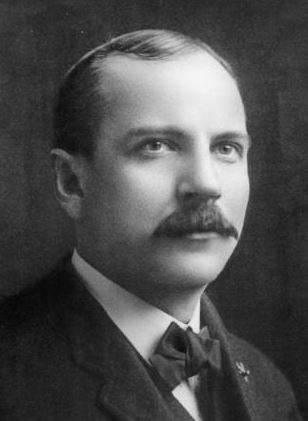 In 1880, she married one of the city's most eligible bachelors, widower Redick M. Ridgley, one of 13 sons of Springfield banker, businessman, landowner, and railroad tycoon Nicholas H. Ridgley (one of seven prominent citizens associated with education in Sangamon County who will be featured in the Sangamon County Historical Society's 2019 Echoes of Yesteryear Oak Ridge Cemetery Walk on October 6). Redick M. Ridgley had four children from his first marriage: Alice, Janey, Redick Jr. and John and two more children with Marie: a son, William and a daughter, Mabel. In 1880, she married one of the city's most eligible bachelors, widower Redick M. Ridgley, one of 13 sons of Springfield banker, businessman, landowner, and railroad tycoon Nicholas H. Ridgley (one of seven prominent citizens associated with education in Sangamon County who will be featured in the Sangamon County Historical Society's 2019 Echoes of Yesteryear Oak Ridge Cemetery Walk on October 6). Redick M. Ridgley had four children from his first marriage: Alice, Janey, Redick Jr. and John and two more children with Marie: a son, William and a daughter, Mabel.
Harry Devereux began his business career with an entry level job at Ridgley National Bank but, as Mitchell notes in his new book, "his curiosity and natural business acumen propelled the young man to succeed at all costs," his set of promotions "aided by his step grandfather, the family patriarch, who was president of the bank until his death in 1888."
And, says Mitchell, "through love or expediency, or both, the Ridgely connection continued in Harry's life." At age 30, in 1895, Devereux married his step-sister, Alice Ridgely. She died three years later in childbirth, leaving him with a son, also named Harry. In 1915, he married Nell Selby. They had no children. Devereux died in 1926. preceded by his wife who died in 1918. He was survived by his son and a grandson.
Devereux's main accomplishment, beyond his other business, civic, and political activities and family responsibilities, was the founding of the Chicago-Springfield Coal Company that, says Mitchell, was successful on several levels, not the least of which is "the development of a little village on the north end of Springfield that bears his name and ensures a lasting legacy."
(Posted 9/2/19)
Annual Oak Ridge Cemetery Walk Set for October 6
The Sangamon County Historical Society's annual Echoes of Yesteryear Oak Ridge Cemetery Walk will be held on Sunday, October 6 and if past years are any measure, it will attract a substantial turnout, says committee chair Mary Alice Davis.
"The annual walk continues to grow and we expect that this year it could well set a record, The event has drawn several thousand participants in its 18-year history, many coming from out of the area to take advantage of this opportunity to tour Oak Ridge in a unique way," she adds.
Oak Ridge is the second most visited national cemetery in the Nation, surpassed only by Arlington in Washington D.C.
Every year the Society’s Oak Ridge cemetery walk focuses on seven people whose lives had an impact on Sangamon history, with period-garbed actors portraying each figure.
Last year, as an official Illinois State Bicentennial Event, participants stopped at the grave sites of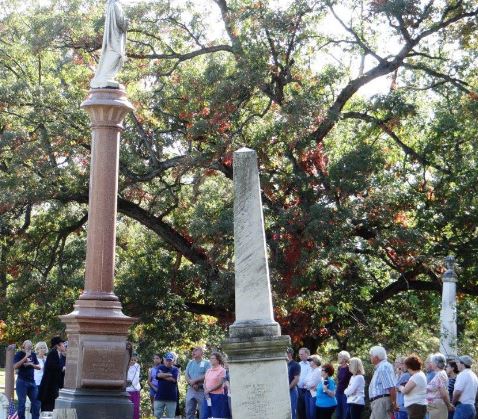 individuals who played a prominent role in the state's 200 year history: Lincoln's first law partner, John Todd Stuart; civic leader Martha Hicklin, board member and treasurer of the Lincoln Colored Home; Catharine Bergen Jones who cast her first ballot in 1914 at age 97, the first time women in Illinois were allowed to vote in municipal elections; John Kelly, the first settler of Springfield; Carrie Post for whom the King's Daughters Home in Springfield was named; Catharine Frazee Lindsay, mother of poet Vachel Lindsay; and Moses Broadwell, Clayville founder. individuals who played a prominent role in the state's 200 year history: Lincoln's first law partner, John Todd Stuart; civic leader Martha Hicklin, board member and treasurer of the Lincoln Colored Home; Catharine Bergen Jones who cast her first ballot in 1914 at age 97, the first time women in Illinois were allowed to vote in municipal elections; John Kelly, the first settler of Springfield; Carrie Post for whom the King's Daughters Home in Springfield was named; Catharine Frazee Lindsay, mother of poet Vachel Lindsay; and Moses Broadwell, Clayville founder.
This year, tour takers will learn about the lives of six community leaders whose names are associated with Sangamon County schools: James H. Matheny, Elijah Iles, Jesse Dubois, Jacob Bunn, William Butler, Nicholas H. Ridgley, seventh stop at the grave site of the first woman elected to the Springfield school board, Mary Logan Morrison.
The two-hour tour will run from Noon to 4 p.m. (the last group will start at 3:15 p.m.). Tour takers will be bused from the starting point at the Oak Ridge Bell Tower to the first gravesite, then will walk to other sites (a distance totaling about a half mile) before boarding the bus to return down the hill to the starting point.
Free parking will be available. The tour is free but a free-will offering will be accepted.
The 365-acre Oak Ridge Cemetery, bordered on the west by North J. David Jones Parkway (North Walnut Street) and North First Street on the east in Springfield, is the largest municipal cemetery in Illinois.
At the walk, attendees will be able to purchase both publications from the Society and snacks and water from the Springfield and Central Illinois African American History Museum.
They also will be able to view the reproduction of Lincoln's funeral hearse from the P.J. Staab Family Funeral Home that was created for the Lincoln Funeral Reenactment in May 2015 on the 150th anniversary of the President's funeral. (The original was destroyed by fire in 1887).
The cemetery walk, co-sponsored by the Society and Oak Ridge Cemetery, was held annually for 13 years beginning in 1996 and ending in 2008. It was brought back five years ago by popular demand.
(Posted 9/2/19)
October 22 Program Meeting
Historian to Separate Myth From Fact in Lincoln’s Assassination
Historian Timothy S. Good will take a myth-busting look at Lincoln’s assassination when he speaks to the Society on Tuesday, October 22.
The date is a week later than the Society’s normal monthly program schedule, but will be held as usual in Carnegie Room North, at the City of Spring-field’s Lincoln Library starting at 5:30 p.m. The 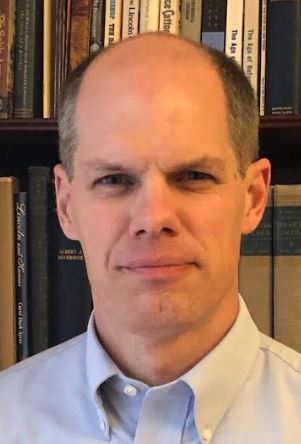 session is free and open to the public. session is free and open to the public.
Good, whose first book, “We Saw Lincoln Shot: One Hundred Eye Witness Accounts” will be the basis of his presentation at the October 22 meeting, has also written three other books, “American Privateers in the War of 1812: The Vessels and Their Prizes as Recorded in Niles’ Weekly Register,” “ Lincoln for President: An Underdog’s Path to the 1860 Republican Nomination” and “The Lincoln-Douglas De-bates and the Making of a President,” all areas of interest to the 28-year veteran of the National Park Service who was appointed Superintendent of the Lincoln Home National Historic Site in Springfield in 2018.
Good holds a Bachelor of Arts degree from Valparaiso University, a Master of Arts from the University of Durham, England, and earned a diploma from the United States Naval War College.
Good began his career with the NPS in Washington D.C. at the Ford’s Theater National Historic Site. He has held several national and regional leader-ship posts, most recently as site superintendent for the Ulysses S. Grant site in Missouri be-fore being named to supervise the Lincoln Home National Historic Site He worked at the site from 1996 to 2001. For his book about Lincoln’s assassination, Good drew on 100 accounts of eyewitnesses, reconstructing from their statements an overview of events and an analysis of the sometimes contradictory statements that suggest conclusions that differ
(Posted 9/2/19)
Chatham Library Teams With Illinois Humanities for Portrayal of Elizabeth Keckley
In a program made possible through the Illinois Humanities Road Scholar Program, area history buffs will be able to learn more about Elizabeth Keckley--dressmaker and confidant to Mary Todd Lincoln-- in a special program on Saturday, September 21 at 1 p.m. Keckley will be portrayed by Marlene Rivero who will relate the story of Mrs. Keckley who had been enslaved, purchased her own freedom, and became Mrs. Lincoln's dressmaker. During a time in our history when it was unheard of for a Black woman to own a business, she did just that, eventually employing over 20 women. The public is invited to attend the presentation at the Library, 600 E. Spruce Street in Chatham. For information call 217-483-2361 or go to chathamlib.org.
(Posted 7/31/19)
SOCIETY ELECTS OFFICERS FOR 2019-2020
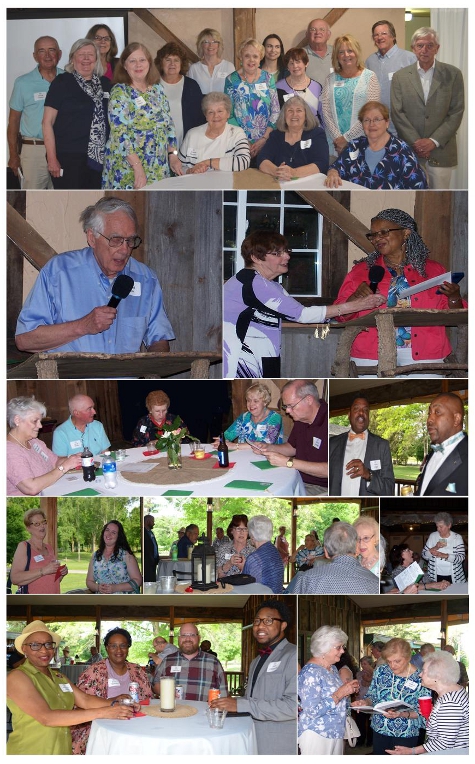 At its annual meeting on Tuesday, June 18, members of the Sangamon County Historical Society elected officers to lead the Society in 2019-2020. At its annual meeting on Tuesday, June 18, members of the Sangamon County Historical Society elected officers to lead the Society in 2019-2020.
Incumbent Vicky Whitaker was re-elected to a second one-year term as president. Whitaker previously served as vice-president and is editor of the Society's monthly newsletter, Historico.
Stephanie Martin, who previously served on the board and chaired the Society's membership committee, was elected vice-president. Mary Mucciante, who also served as a director of the Society, was elected secretary. Incumbent Jerry Smith was re-elected treasurer.
The Society's 15 board of directors serve staggered three-year terms. When board vacancies arise, candidates can seek to fill the remainder of the term. Elected to the board for a three year term ending in 2022 were Jennie Battles, Kathy Dehen, Mary Schaefer, Larry Stone, Angela Weiss. Elected to fill a one-year vacancy on the board ending in 2020 was Elaine Hoff.
For a full list of the 2019-2020 officers, board and committees go to CONTACT US.
The election was held at the Society's annual dinner held at the Pleasant Plains Historical Society's Clayville Historic Site in Pleasant Plains,15 miles west of Springfield.
The evening began with a pre-dinner gathering in the new covered outdoor pavilion adjoining the air-conditioned Cunningham Barn which housed the business and dinner portion of the meeting. Historian and past president David Scott was the keynote speaker whose talk focused on the forces that shaped Illinois. Following the meeting, attendees were given a tour of the site that included the restored Broadwell Tavern, a former inn and stagecoach stop built in 1824 that’s listed on the National Register of Historic Places. Photos by Kathy Dehen
(Posted 7/31/19)
FIVE COMMUNITY GROUPS WIN SOCIETY'S
SPECIAL PROJECTS GRANTS AWARD
Winners of the Sangamon County Historical Society's Special Projects Grants were announced June 18 at the Society's Annual Dinner, held this year at the Clayville Historic Site in Pleasant Plains.
Using a PowerPoint display that illustrated each proposal, Elaine Hoff, chair of the Society's Special Projects Grants committee, revealed the names of each recipient and introduced representatives of the organizations who attended the event as guests of the Society. They, in turn, provided dinner goers with details of their projects.
The 2019 recipients are:
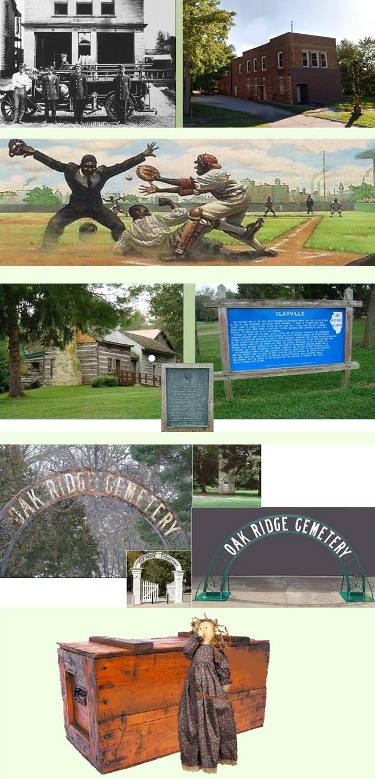 Central 3 Community First Project Inc., $1,000. Central 3 Community First Project Inc., $1,000.
Project: Signage for first black firehouse in Springfield describing its history and role in the 1908 race riot. An architectural drawing of the new façade will be added following completion of restoration.
Springfield And Central Illinois African American History Museum,: $1,000.
Project: Exhibit on the national Negro League players from Springfield and Central Illinois and their impact on area baseball.
Pleasant Plains Historical Society, $500. (Catlin Memorial Award)
Project: Refine and rebuild wheel chair ramps to three historic buildings at its Clayville Historic Site. One award each year is designated the Donna Catlin Memorial Award in memory of the Society's late photographer, Donna Catlin who was widely known for her photographs of historic sites, amiong them Clayville.
Oak Ridge National Cemetery, $500
Project: Create an interpretive marker with historical information about the former third street enrance sign (circa 1900), now restored and ready for display at the cemetery bell tower.
Springfield Art Association/Historic Edwards Place, $500.
Project: Traveling history trunk program to bring history into the classroom.
(If you'd like to know more about the Society's Special Project Grants program and read more the past projects that have been funded, see GRANTS).
(Posted 7/31/19)
COMMITTEE MEETS TO SHAPE OCTOBER 6
17th ANNUAL OAK RIDGE CEMETERY WALK
Plans for the Society's Annual Echoes of Yesteryear Oak Ridge Cemetery Walk on Sunday, October 6, have begun, kicked off in May with site selections, followed by a committee meeting in June that included the first trial walk, all underscoring the areas it must address in planning an event that continues to break attendance records.
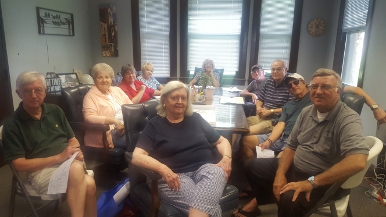 In addition to chairperson Mary Alice Davis (seated, center), members of the committee are (from left) Jerry Smith, Jennie Battles, Linda Schneider, Ruth Slottag, Susan Helm, Mike Kienzler, Ernie Slottag, Pete Harbison and Mike Lelys, executive director of Oak Ridge. Also serving on the committee but not pictured are Curtis Mann and Larry Stone. In addition to chairperson Mary Alice Davis (seated, center), members of the committee are (from left) Jerry Smith, Jennie Battles, Linda Schneider, Ruth Slottag, Susan Helm, Mike Kienzler, Ernie Slottag, Pete Harbison and Mike Lelys, executive director of Oak Ridge. Also serving on the committee but not pictured are Curtis Mann and Larry Stone.
The walk, free and open to the public, will have stops at the grave sites of six early Sangamon County residents who have schools named for them and a seventh stop at the grave site of the first woman elected to the Springfield school board. Dressed in period costumes, re-enactors at each site will take the audience back to an earlier time, providing insight into the personal lives of the individuals they are portraying based on extensive historic research.
The event will run from Noon to 4 p.m., with the last tour starting at 3:15 p.m.
The 365-acre Oak Ridge Cemetery, bordered on the west by North J. David Jones Parkway (North Walnut Street) and North First Street on the east in Springfield, is the largest municipal cemetery in Illinois and is the second most visited cemetery in the United States after Arlington National Cemetery near Washington, D.C.
Attendees will be transported by bus from the start of the tour at the Oak Ridge Bell Tower, to the first gravesite, then walk to the other gravesites before boarding the bus to return down the hill to the starting point, a distance of about a half mile.
At the walk, attendees will be able to purchase both publications from the Society and snacks from the Springfield and Central Illinois African American History Museum. They also will be able to view the reproduction of Lincoln's funeral hearse from the P.J. Staab Family Funeral Home that was created for the Lincoln Funeral Reenactment in May 2015 on the 150th anniversary of the President's funeral. (The original was destroyed by fire in 1887).
The cemetery walk, co-sponsored by the Society and Oak Ridge Cemetery, was held annually for 12 years beginning in 1996 and ending in 2008. It was brought back five years ago by popular demand.
(Posted 7/31/19)
EIGHTH ANNUAL TRIVIA NIGHT DATE SET
Trivia fans will have lots of time to put on their thinking caps.
Fresh from its most successful Trivia Night to date, the Society has set the date for its 2020 version: Saturday, March 21.
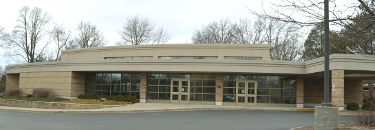 "The location, Parish Hall at Christ the King Church in Springfield (right), will remain the same," says Mary Alice Davis, co-chair of the Society's Programs & Events committee who has guided the event since its inception. "The location, Parish Hall at Christ the King Church in Springfield (right), will remain the same," says Mary Alice Davis, co-chair of the Society's Programs & Events committee who has guided the event since its inception.
"This is our major fundraiser that helps underwrite our Special Projects Grant program, so we wanted to make sure that the date is on the radar, especially among die-hard trivia players who look forward to our event." Doors will open at 6 p.m. and as in past years, you'll be able to reserve and pay for tables of and individual seats on line or by mail. "It's always a fun night," Davis adds.
|

